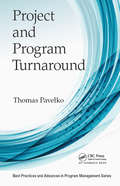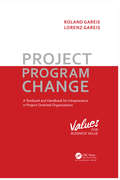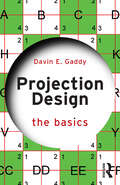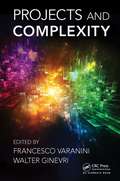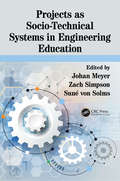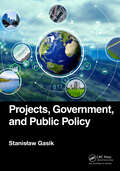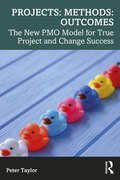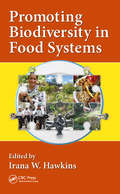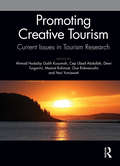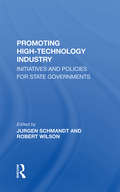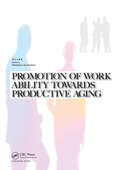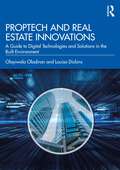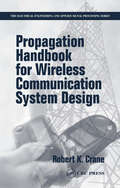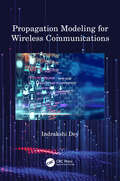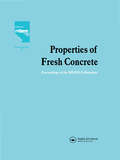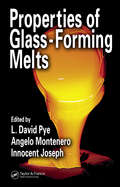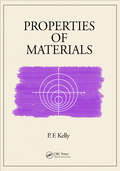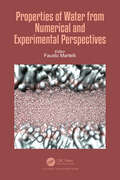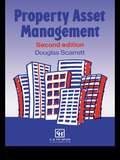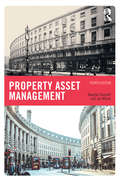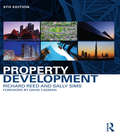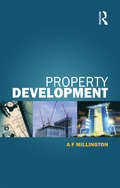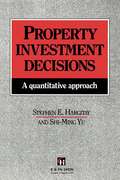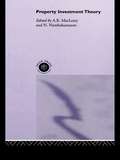- Table View
- List View
Project and Program Turnaround (Best Practices in Portfolio, Program, and Project Management)
by Thomas PavelkoThe U.S. economy thrives on the development of new products, new systems, and new processes. Usually, these advances start as a flash of inspiration by highly creative individuals. It is complex and difficult to go from initial inspiration to a final product, process, or system. So it is not surprising that approximately one out of every four development programs fails. A development program or project in trouble is distinct from a program encountering typical development difficulties. Such a program or project can appear to be in free fall. This book identifies the essential fundamentals for executing a program or project turnaround effectively. These fundamentals include: Clearly identifying the next critical accomplishment needed for success Assigning responsibility for each program task to one person Capitalizing on colocation and face-to-face communication Recruiting problem solvers Wining commitment from team members Using team accomplishments to propel high team morale The guidance provided in this book is applicable to all program or project genres, including manufacturing, nonprofit work, education, medicine, investment management, and municipal management. Software has become a great part of both providing product functionality and assisting with managing product development. A special chapter devoted to software development dispels common misconceptions and provides guidance for turning around this special type of project or program. This book is a highly valuable source of insight for a wide range of readers, including management professionals, business students, and executive managers. Every member of a product or project development team will find its recommendations to be of high value.
Project. Program. Change
by Roland Gareis Lorenz GareisThis book gives managers an integrative approach to project, program, and change management. It describes the differences between change in projects versus programs with case studies in both areas and the different life cycles. While the project and change comprise much of the book, it is up to date with its emphasis on agile, scrum, and benefits. The book also describes methods to both initiate and manage a change and what must be done for success and business value.
Projection Design: The Basics (The Basics)
by Davin E. GaddyProjection Design: The Basics explores the concepts of visual elements in live entertainment. It provides a conversational view of the fundamentals of projection design, from production meetings and the elements of visual design to the equipment necessary to make it all happen.This text examines the themes and theories universal to a wide range of topics, to provide a foundation for anyone interested in using video for their live production or those who are looking where to start as a designer. Topics covered include: Methods of extracting visuals from a script and communicating them to production staff Basics of visual design Understanding human perception and how this influences design How to choose the right equipment to build a system With a detailed glossary, basic formulas, and comprehensive explanation from start to finish, Projection Design: The Basics is an ideal primer for Projection Design courses, and will be of interest to anyone entering the field of projection and media design for the first time.
Projects and Complexity: Theory, Methods, And Applications (Systems Innovation Book Ser.)
by Adedeji B. BadiruHelpful to those tasked with managing complex environments, Projects and Complexity introduces a new way of looking at projects and fostering the culture needed to achieve sustainable results. It brings together experts from the academic, military, and business worlds to explore project management in the context of complexity theory and organizatio
Projects as Socio-Technical Systems in Engineering Education
by Johan Meyer Zach Simpson Suné Von SolmsThis book presents the case for Project-Based Learning within Socio-Technical Systems in Engineering Education. The book highlights the importance of projects as Socio-Technical Systems as a means for supporting and enhancing international accreditation of engineering programs. Practical examples illustrate how Socio-Technical Systems are brought into the educational environment through Project-Based Learning. The book goes on to discusses the impact this may have on Engineering Education practice. <P><P>The work presented will enable engineering educators to develop curricula that can respond to societal needs, while also enhancing teaching and learning. It offers an approach to engineering education that centers on engaging scholars in projects that are located within socio-technical systems. University, government and industry leaders will gain from this book as it provides insight into strategic planning and partnership-building for Engineering Education. We hope this book will further foster deep scholarship of research to ready engineering faculties for engaging responsibly with their surrounding communities. <P><P>Features: <li>Offers applications of Project-Based Learning (PBL) in Engineering Education <li>Matches elements of Socio-Technical Systems in Higher Engineering Education, with the Exit Level Outcomes (ELOs) required by professional engineering bodies <li>Provides practical examples for the establishment of project environments within an academic faculty <li>Shows examples in the success of execution of projects involving engineering educators, researchers, program developers, government agencies and industry partners <li>Presents a framework to develop Project-Based Learning in Engineering Education that addresses Socio-Technical requirements and will enable engineering educators to collaboratively develop engineering curricula with industry that will respond to societal needs
Projects, Government, and Public Policy
by Stanisław GasikMany governments have effectively organized public project implementation systems in their jurisdictions. At the same time, many other countries remain at a less advanced level of public project management. Globally, there is a need for project management knowledge to be transferred between governments. However, no systematic review of these practices has been developed to date. Projects, Government, and Public Policy was written to fulfill this need and presents a review of project management practices in countries with developed project-based capabilities. This book uses its own rigorous model to present this review systematically. This book’s practical purpose is to give a structured overview of government-level project management practices. This knowledge can be used in the work of governments to improve the management of public projects and the implementation of public policies. Many professionals working in public institutions understand project management concepts differently than project management professionals. Therefore, this book begins with a chapter that describes the differences between the conceptual basis of public administration and project management. The body of this book has five parts. Part I is mainly intended for those involved in government and public administration who want to acquire or increase knowledge about project management. Part II provides an overview of the basic concepts from the theory of public administration, public policies, and development management. Part III describes what makes public projects unique and the success factors specific to projects of this sector. Knowledge about effective government project management practices is covered in Part IV. The concluding Part V begins with a general overview of the maturity model concept. Its main part covers the description of a maturity model showing ways to systematically improve the implementation of public projects. This book is written for governments and government administrators, including the most influential decision-makers, who craft policies to guide a country’s development as well as how to implement projects. This book is also intended for supporters and enthusiasts of project management in government and public administration by providing them with a description of the solutions used by project management in public administration. This book is intended, too, for all project management practitioners working for public projects: project managers, team members, sponsors, and middle-level executives of project-delivering private companies. By knowing public administration concepts, they can manage their projects better and use a common language with their clients.
Projects: The New PMO Model for True Project and Change Success
by Peter TaylorMatching the speed of change in modern business, this book takes readers on a two-year journey in building a project management office (PMO) for today and tomorrow and redefines the PMO as to what it should focus on: Projects, Methods, and Outcomes. Many organisations invest heavily in PMOs, but these are built on an outdated and static model that does not fit a hybrid, agile, AI-empowered, and rapidly changing business environment. Building on his renowned "balanced PMO" model, project management leader Peter Taylor tackles today’s challenges with this diary-style guide to inspire all PMO leaders, project managers, and business leaders, and provide a roadmap to follow to build (or rebuild) their own PMOs. He presents a completely new definition of "PMO", eliminating the traditional back-office concept of a centralised PMO, with his "Projects: Methods: Outcomes" construct that provides a truly business focused team to oversee the delivery of value to their organisation. Enriched with case studies and practical models, this book will benefit all PMO leaders, project management professionals, change and transformation leaders, and anyone interested in how to deliver business value through projects.
Promise and Performance Of Environmental Conflict Resolution
by Lisa Bingham Rosemary O'LearyEnvironmental conflict resolution (ECR) is a process of negotiation that allows stakeholders in a dispute to reach a mutually satisfactory agreement on their own terms. The tools of ECR, such as facilitation, mediation, and conflict assessment, suggest that it fits well with other ideas for reforming environmental policy. First used in 1974, ECR has been an official part of policymaking since the mid 1990s. The Promise and Performance of Environmental Conflict Resolution is the first book to systematically evaluate the results of these efforts. The Promise and Performance of Environmental Conflict Resolution presents empirical research along with insights from some of ECR?s most experienced practitioners. Beginning with a primer about concepts and methods, the book describes the kinds of disputes where ECR has been applied, making it clear that 'despite the faith of proponents in the power and usefulness of ECR, it is not applicable to all environmental conflicts.' The contributions that follow critically investigate the record and potential of ECR, drawing on perspectives from political science, public administration, regional planning, philosophy, psychology, anthropology, and law. ECR is being extended to almost every area of environmental policy. Rosemary O'Leary and Lisa Bingham argue that truly effective use of ECR requires something more than advocacy. The Promise and Performance of Environmental Conflict Resolution provides scholars, policymakers, students, and practitioners with critical assessments, so that ECR can be used to its best advantage.
Promoting Biodiversity in Food Systems
by Irana W. HawkinsBiodiversity of the food system is crucial for food production and loss of biodiversity is a pressing issue. This book focuses on biodiversity’s crucial role in food systems, health and well-being, and fate of the natural environment. It provides practical recommendations on how proper food systems can sustain a healthier planet and protect biodiversity. Sections provide a comprehensive understanding of the urgent need for promoting biodiversity-promoting food systems that help maintain planetary boundaries that are at risk; mimic the natural processes of highly integrated ecosystems; and improve human/planetary health while providing a wholesome and sufficient food supply.
Promoting Creative Tourism: Proceedings of the 4th International Seminar on Tourism (ISOT 2020), November 4-5, 2020, Bandung, Indonesia
by A.H.G. KusumahThe papers presented in this work cover themes such as sustainable tourism; ICT and tourism; marine tourism; tourism and education; tourism, economics, and finance; tourism marketing; recreation and sport tourism; halal & sharia tourism; culture and indigenous tourism; destination management; tourism gastronomy; politic, social, and humanities in tourism; heritage tourism; medical & health tourism; film induced tourism; community based tourism; tourism planning and policy; meeting, incentive, convention, and exhibition; supply chain management; hospitality management; restaurant management and operation; safety and crisis management; corporate social responsibility (CSR); tourism geography; disruptive innovation in tourism; infrastructure and transportation in tourism development; urban and rural tourism planning and development; community resilience and social capital in tourism.The 4th ISOT 2020 aimed at (1) bringing together scientists, researchers, practitioners, professionals, and students in a scientific forum and (2) having discussions on theoretical and practical knowledge about current issues in tourism. The keynote speakers contributing to this conference are those with expertise in tourism, either in an academic or industrial context.
Promoting High Technology Industry: Initiatives And Policies For State Governments
by Robert Wilson Jurgen Schmandt Suzanne E Smith Brian H MullerIn the wake of declining federal involvement in state affairs, state governments have taken the initiative in creating science and technology policies and programs for economic development. The contributors to this study look at the attempts of eight states—California, Florida, Massachusetts, Minnesota, New York, North Carolina, Pennsylvania, and T
Promotion of Work Ability towards Productive Aging: Selected papers of the 3rd International Symposium on Work Ability, Hanoi, Vietnam, 22-24 October 2007
by Masaharu KumashiroThis publication is a collection of selected papers from the 3rd International Symposium on Work Ability Promotion of Work Ability Towards a Productive Aging.It addresses the Work Ability Index (WAI) as an index for evaluating work ability, developed by the Finnish Institute of Occupational Health as a tool for evaluating work ability of workers. T
PropTech and Real Estate Innovations: A Guide to Digital Technologies and Solutions in the Built Environment
by Olayiwola Oladiran Louisa DickinsThis textbook serves as a guide to real estate students and educators on the various property innovations and digital technologies that continue to shape the property industry. The advancement of PropTech in the last few decades has led to significant changes in real estate systems, operations, and practice, and this new textbook provides insight on the past, present, and future of PropTech innovations that have spread across the value chain of real estate through planning, development, management, finance, investment, operations, and transactions. The textbook approaches this subject from the real estate components, asset classes, and submarkets and links them to the associated innovations and digital technologies. It concludes by reviewing the role of education, innovation, skill development, and professionalism as major elements of the future of real estate operations and practice.This book’s unique contributions are in putting the “property” element at the forefront and then illustrating how technology can enhance the various areas of real estate; the focus on how the different innovations and technologies can enhance the economic, environmental, social, and physical efficiency of real estate; and its coverage of some non‑technological innovations like flexible working and more practical areas of real estate innovation such as skills, employability, creativity, and education.It contains 21 case studies and 29 case summaries, which can serve as practice exercises for students. This book will be useful to students in helping them build a knowledge base and understanding of innovation and digital technologies in the industry. Real estate educators can use the textbook as a guide to incorporate real estate innovation and digital technologies into their current teaching and also to develop their real estate curricula through PropTech‑related modules and courses where necessary. It will also be valuable to real estate researchers in search of the theoretical and conceptual linkages, as well as industry practitioners who seek insight into the current and future potential of digital technologies and their applications to real estate operations and practice.
Propagation Handbook for Wireless Communication System Design (Electrical Engineering & Applied Signal Processing Series)
by Robert K. CraneData and models for better systems designAtmospheric gases, building materials, the weather � The propagation of wireless communications signals depends upon a whole range of factors, any or all of which can have a significant impact on the quality of a signal. Data generated by careful measurement of signals propagating under various envir
Propagation Modeling for Wireless Communications
by Indrakshi DeyThis book introduces the various approaches and tools used for modelling different propagation environments and lays the foundation for developing a unified theoretical framework for future integrated communication networks. In the case of each type of network, the book uses basic concepts of physics, mathematics, geometry and probability theory to study the impact of the dimension and shape of the propagation environment and relative transmit-receive position on the information flow. The book provides an introduction into wireless communication systems and networks and their applications. For both systems and networks, the basic hard (encoder, modulator, etc.) and soft components (information, signal, etc.) are discussed through schematic block diagrams. Next each of the modes of communication, namely radio waves, acoustic waves, magnetic induction, optical waves, biological particles (molecules, aerosols, neural synapse etc.) and quantum field, are discussed. For each communication scenario presented, the impact of different environmental factors on the propagation phenomenon is articulated, followed by different channel modelling (deterministic, analytical, and stochastic) techniques that are used to characterize the propagation environment. Finally future trends in wireless communication networks are examined and envisioned for next generations 6G/7G of communication systems, like space information networks, sea-to-sky internet of vehicles, and internet of bio-nano things. Based on the future trends of integrated networks, the book drives the need for a generalized channel model irrespective of the media and mode of information transfer. The primary audience for the book is post-graduate students, researchers and academics in electronics and communications engineering, electrical engineering and computer science.
Properties of Fresh Concrete: Proceedings of the International RILEM Colloquium
by H. J. WierigThis book presents new information on concrete properties and production in the light of the widespread use of ready mixed concrete and new concreting materials. This book forms the Proceedings of the RILEM Colloquium held in Hanover, West Germany in October 1990. Papers from 18 countries in Europe, North America and the Far East are included.
Properties of Glass-Forming Melts
by L. David Pye Angelo Montenero Innocent JosephThis book presents state-of-the-art information concerning properties and processes involved in glass melts. Based upon contributions by renowned authors and scientists working with glass melt systems, Properties of Glass-Forming Melts is an excellent compilation of the current knowledge on property data, mechanisms, measurement techniques, and str
Properties of Materials
by P.F. KellyThe second volume in the author's three-part series, Properties of Materials uses the principles of classical mechanics to qualitatively and quantitatively model specific features of matter.The text develops linear models of elasticity to correlate and quantify the changes in an object's shape induced by the application of a constant force. It desc
Properties of Water from Numerical and Experimental Perspectives
by Fausto MartelliAs the most important liquid in our life and one of the most abundant molecules in the universe, water is the least understood substance with a very rich phase diagram (at least 18 crystalline forms and two liquids) and more that 60 dynamical/thermodynamic anomalies whose origins are still under debate. Properties of Water from Numerical and Experimental Perspectives gathers together leading scientists and experts in the field of water. By merging the theoretical/computational point of view with experimental approaches, it presents a state-of-the-art description of the properties of water, enlightening the source of the anomalies of water and describing how such anomalies actively affect the functioning of biological substances.
Property Asset Management
by D. ScarrettProperty has unique characteristics, both as an investment and as an operational holding. A thorough understanding of this dual role is needed by professionals responsible for maximising a property's full potential. Property Asset Management emphasizes the need for a strategic plan in property management as well as for efficient day-to-day practice.
Property Asset Management
by Douglas Scarrett Jan WilcoxProperty asset management requires both day-to-day oversight of rental properties and an ability to maximize the potential of the portfolio through forward thinking and practical planning. Successful property managers must be flexible and proactive whilst maintaining a robust knowledge of technical, financial and legal aspects of the leasing system. Property Asset Management is a practical guide to the key principles of successful property management, perfect for both student and practitioner alike. In this book, Douglas Scarrett and Jan Wilcox demonstrate how to successfully manage properties for the varying needs of clients ranging from individual property owners to large international commercial ventures. As well as the basic theory, Property Asset Management discusses the process of active management, the strategic objectives, performance measurement, and the key financial and operational information needed for high quality and comprehensive reporting to clients. This fourth edition has new chapters on corporate real estate and financial management, and has been extensively rewritten to incorporate recent developments in property management. Software screenshots are used to illustrate salient points and readers are provided with a thorough overview of the latest legal aspects of land ownership and tenancy arrangements. With everything you need for successful property asset management, this book both caters for the needs of RICS accredited and business courses and serves as a handy guide for everyday practice.
Property Development
by Richard Reed Sally SimsThe 6th edition of this extremely popular and classic textbook has been updated to reflect ongoing changes in the field of property development. Attention is paid to the impact of the global financial crisis on the property development process and, in addition, to the increasing relevance of technology to the property profession. Whilst the successful style and format of the text has been retained, new chapters have been added and existing chapters updated and enhanced to guide lecturers and students in their teaching, reading and studying. Other new features in this edition include: Fully updated discussion points and reflective summaries Examples of contemporary best practice based on international case studies covering the UK, USA and Australia New chapters on 'Property Cycles' and 'Technology' Online materials for lecturers and students This fully revised edition of a standard text for all property development and real estate students will also be of interest to early career professionals and those pursuing similar professional degrees in the industry and in wider built environment courses.
Property Development
by Alan Millington"Property Development" includes such considerations as the objectives, functions, roles and methods of operation of all those involved in the development process, the financial aspects of development, social considerations, planning matters, and others, providing readers with the opportunity to develop their understanding of and their expertise in, the subject.
Property Investment Decisions: A quantitative approach
by S. Hargitay S Hargitay S-M YuThe importance of property as an investment medium continues to grow. Investors in property or those involved with the provision of expert advice to investors have had to improve the effectiveness and efficiency of their decision making. The aim of this book is to lay down the theoretical foundations of investment decision making, incorporating the techniques and procedures of modern management science, so that particular decisions regarding property investment can be made efficiently and rationally.
Property Investment Theory
by A. R. MacLeary N. NanthakumaranThis up-to-date reference on property investment highlights the problems with existing techniques of property valuation and appraisal and identifies possible ways forward for both research and practice.
